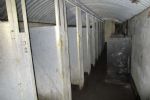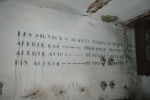Fort de Tancremont
Le fort de Tancrémont est une évolution du concept de construction des forts belges établi par le Général Henri Alexis Brialmont avant la Première Guerre mondiale, le fort formant un ensemble relativement compact de tourelles à canon et de postes d'observation situé sur un massif central en béton non-renforcé, entouré par un fossé défendu.
Cela contrastait avec les fortifications françaises contemporaines de la ligne Maginot basée sur le concept de 'fort articulé' qui ne possède pas de périmètre défini. Les nouveaux forts belges, bien que plus conservateurs dans leur conception que les ouvrages français comportent de nombreuses améliorations tirées de l'expérience de la Première Guerre mondiale.
Les tourelles d'artilleries sont moins étroitement groupées, le béton simple a été remplacé par du béton armé et son placement s'est fait avec le plus grand soin pour éviter les joints faibles; la ventilation a été grandement améliorée; les dépôts ont été profondément enterrés et protégés et les sanitaires les zones de vie pour la garnison ont fait l'objet d'une plus grande attention.
Tancrémont était parmi les plus petits des nouveaux forts belges, armé d'un calibre maximum de 75 mm.
Ces canons n'avaient pas une portée suffisante pour fournir un support mutuel entre forts voisins. Le fort comportait 5 blocs de combat situés sur une crête entre Pepinster et Theux. Seul le sommet des blocs est visible, le reste du fort étant enterré.
Bloc B.I, en temps de paix, le bloc d'entrée avec une cloche d'observation et équipé de projecteurs.
Bloc B.II, équipé de tourelles rétractables armées canons jumelés de 75 mm.
Bloc B.III, 3 cloches d'observation avec périscope et mitrailleuse Bloc B.IV, semblable au bloc B.II.
Bloc B.M., situé au centre du fort, équipé de 3 mortiers de 81 mm et d'un bloc d'observation.
Le fort comporte également des coffres de contre-escarpe dont le but est de protéger les fossés avec des canons anti-char de 47 mm, des mitrailleuses et des lanceurs de grenade. Ils sont désignés C.II, C.III et C.IV. Deux blocs de ventilation désignés B.O. et B.P. fournissent l'air. B.P. est situé au-dessus des principaux locaux d'habitation, faisait office d'entrée en temps de guerre et était armée de mitrailleuse.
Le bloc B.O. servait quant à lui également de sortie d'urgence. B.O. et B.P. sont situés en dehors du périmètre de défense et accessibles par des galeries profondément enfouies. Le fort incluait une fausse coupole nommé K. Le réseau souterrain comporte un peu moins de 2 km de galeries situées entre 20 et 28 m sous la surface et reliant le poste de commandement, les logements, la centrale électrique, les postes de combats et les magasins de munitions. La construction fut dirigée par le Lieutenant Victor Gérard. Les principaux canons de 75 mm était des Bofors modèle 1934 fabriqués à la Fonderie Royale des Canons (FRC). Les canons de 47 mm étaient des canons FRC modèle 1936. Il était prévu à l'origine que le fort de Tancrémont soit équipé de canons de 120 mm comme Ében-Émael et Battice mais le bloc B.III ne reçut finalement que des mitrailleuses En 1940, le fort était sous le commandement du Capitaine-Commandant Abel Devos du 4e Bataillon du Régiment de Forteresse Liégeois commandé par le Major Parmentier.
En 1940, le fort était manœuvré par 15 officiers, 54 sous-officiers et 500 soldats dans le fort.
Photos : Alain Walthery
Texte : wikipédia





